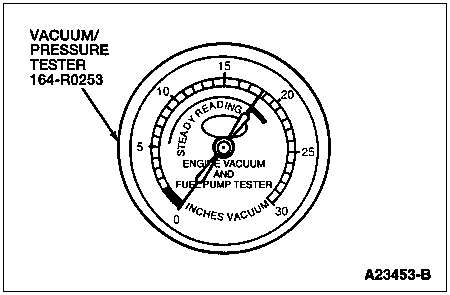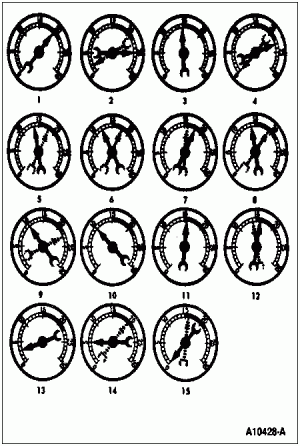Yo,
A previous owner or shop may have swapped a 94 through 96 5.0 or even a 5.8 in.
Check the casting number; on the small block V8, it's is above the starter.
For example;
http://s420.photobucket.com/user/th3jessejames/media/Picture111.jpg.html
F4T = 94 Truck: 4C1 = March 1 1994
See
http://reincarnation-automotive.com/casting-numbers-page-2-ford-casting-numbers-explained.html
https://classicmustang.com/decoding-part-numbers/
○
94 through 96 5.0 and All 5.8 have same firing orders,
1-3-7-2-6-5-4-8 . On these vehicles, the #1 and #3, or #5 and #6 spark plug wires must be separated to eliminate the possibility of an induction crossfire. To eliminate the possibility of the coil wire becoming disconnected, route the coil wire under the spark plug wires at the distributor cap.
○
If you still have DTC 33, it must be solved. DTC 33 is triggered when the EVP sensor is not closing.... To prevent the EGR valve from opening when the engine is cold, vacuum is not allowed to pass to the valve until the engine is warm. EGR isn't needed when the engine is cold, only when it is warm and under load.
○
"Dotted needle"; is in my vacuum leak test hot link;
such as in #2, "NORMAL READING DURING RAPID ACCELERATION AND DECELERATION... "engine is rapidly accelerated (
dotted needle), needle will drop to a low (not to zero) reading." Note that the dotted neeedle is shown near zero on the gauge.
Section 03-00: Engine, Service
Workshop Manual
SERVICE PROCEDURES
Intake Manifold Vacuum Test
Bring the engine (6007) to normal operating temperature. Connect Rotunda Vacuum/Pressure Tester 164-R0253 or equivalent to the intake manifold (9424). Run the engine at the specified idle speed.
The vacuum gauge should read between -51 and -74 kPa (15 and 22 in-Hg) depending upon the engine condition and the altitude at which the test is performed. SUBTRACT 5.5 kPa FOR EVERY 500 METERS ABOVE SEA LEVEL. SUBTRACT ONE INCH FROM THE SPECIFIED READING FOR EVERY 1,000 FEET OF ELEVATION ABOVE SEA LEVEL.
The reading should be quite steady. It may be necessary to adjust the gauge damper control (where used) if the needle is fluttering rapidly. Adjust damper until needle moves easily without excessive flutter.
Vacuum Gauge Readings, Interpretation
A careful study of the vacuum gauge reading while the engine is idling will help pinpoint trouble areas. Always conduct other appropriate tests before arriving at a final diagnostic decision. Remember that vacuum gauge readings must be interpreted with care.
Most vacuum gauges have a "normal" band indicated on the gauge face.

Following are potential gauge readings. Some should be considered as normal; others should be investigated further.

- NORMAL READING: Needle between -51 and -74 kPa (15 and 22 in-Hg) and holding steady.
- NORMAL READING DURING RAPID ACCELERATION AND DECELERATION: When engine is rapidly accelerated (dotted needle), needle will drop to a low (not to zero) reading. When throttle is suddenly released, the needle will snap back up to a higher than normal figure.
- NORMAL FOR HIGH LIFT CAM WITH LARGE OVERLAP: Needle will register as low as -51 kPa (15 in-Hg) but will be relatively steady. Some oscillation is normal.
- WORN RINGS OR DILUTED OIL: When engine is accelerated (dotted needle), needle drops to 0 kPa (zero in-Hg). Upon deceleration, needle runs slightly above 74 kPa (4 in-Hg).
- STICKING VALVE(S): When the needle (dotted) remains steady at a normal vacuum but occasionally flicks (sharp, fast movement) down and back about 13 kPa (4 in-Hg), one or more valves may be sticking.
- BURNED OR WARPED VALVES: A regular, evenly spaced, downscale flicking of the needle indicates one or more burned or warped valves. Insufficient hydraulic lash adjuster clearance will also cause this action.
- POOR VALVE SEATING: A small but regular downscale flicking can mean one or more valves are not seating.
- WORN VALVE GUIDES: When the needle oscillates (swings back and forth) over a 13 kPa (4 in-Hg) range at idle speed, the valve guides (6510) could be worn. As engine speed is increased, the needle will become steady if the guides are responsible.
- WEAK VALVE SPRINGS: When the needle oscillation becomes more violent as engine rpm is increased, weak valve springs (6513) are indicated. The reading at idle could be relatively steady.
- LATE VALVE TIMING: A steady but low reading could be caused by late valve timing.
- IGNITION TIMING RETARDING: ******** ignition timing will produce a steady but low reading.
- INSUFFICIENT SPARK PLUG GAP: When spark plugs (12405) are gapped too close, a regular, small pulsation of the needle can occur.
- INTAKE LEAK: A low, steady reading can be caused by an intake manifold or throttle body gasket (TB gasket) (9E936) leak.
- BLOWN HEAD GASKET: A regular drop of approximately 33-50 kPa (10-15 in-Hg) can be caused by a blown head gasket (6051) or warped head-to-block mounting surface.
- RESTRICTED EXHAUST SYSTEM: When the engine is first started and is idled, the reading may be normal. As the engine rpm is increased, the back-pressure caused by a clogged muffler, kinked tail pipe, etc., will cause the needle to slowly drop to zero. The needle then may slowly rise. Excessive exhaust clogging will cause the needle to drop to a low point even if the engine is only idled.
When vacuum leaks are indicated, search out and correct the condition. Excess air leaking into the system will upset the fuel mixture and cause conditions such as rough idle, missing on acceleration, or burned valves. If the leak exists in an accessory unit, such as the power brake, the unit will not function correctly. ALWAYS SERVICE VACUUM LEAKS.


